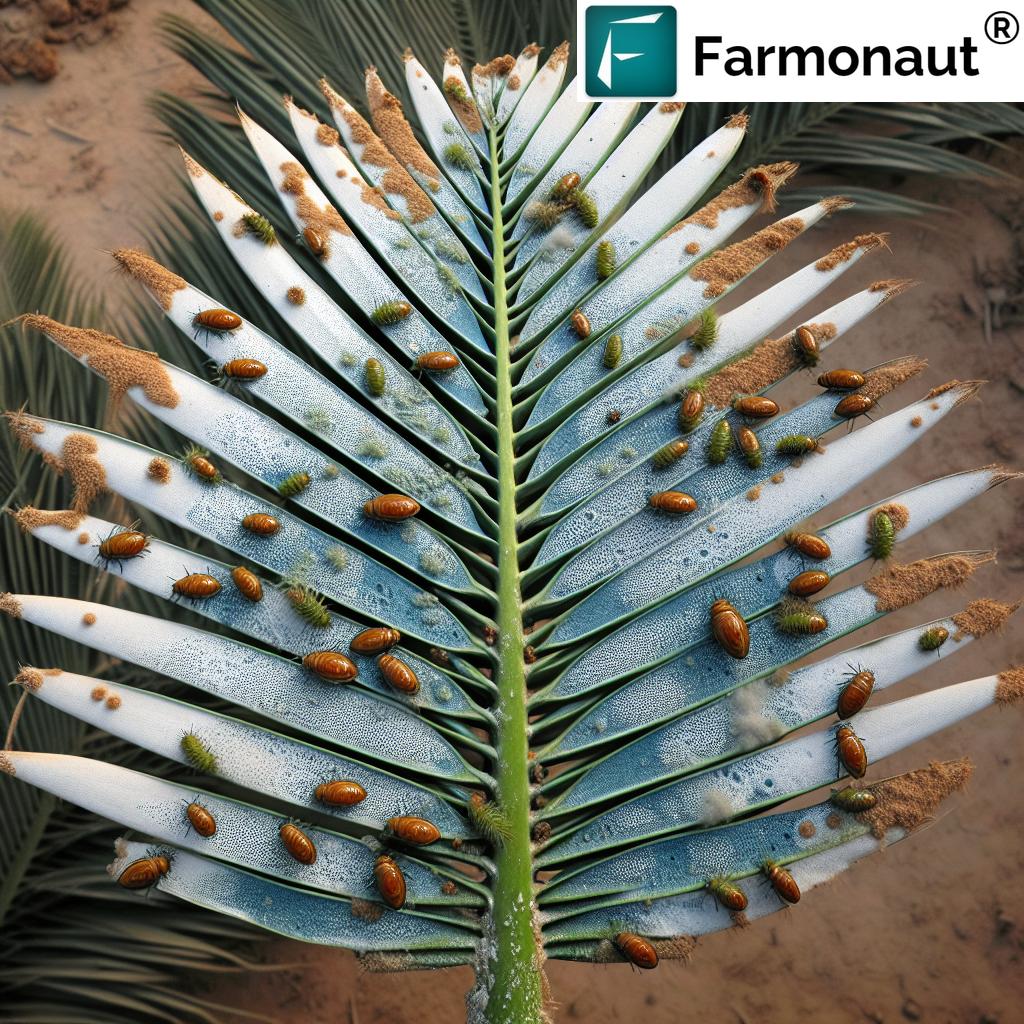Organic vs. Chemical: Effective Dubas Pest Control Strategies for Date Palm Plantations

In the world of date palm cultivation, few challenges are as persistent and damaging as the dubas bug (Ommatissus lybicus). This tiny yet formidable pest has been the bane of date palm farmers for generations, causing significant economic losses and threatening the sustainability of this vital crop. At Farmonaut, we understand the critical importance of effective pest management in maintaining healthy date palm plantations and ensuring optimal yields. In this comprehensive guide, we’ll explore both organic and chemical control methods for dubas pest, weighing their effectiveness, environmental impact, and long-term sustainability.
Understanding the Dubas Pest: A Menace to Date Palm Plantations
Before delving into control strategies, it’s crucial to understand the nature of our adversary. The dubas bug is a sap-sucking insect that specifically targets date palms, causing extensive damage to these valuable trees.
Life Cycle and Behavior
- Nymphs and Adults: Both stages of the dubas bug feed on the sap of date palms, weakening the trees.
- Infestation Sites: They primarily attack the fronds and leaves, but can also infest fruit clusters.
- Seasonal Activity: Dubas bugs typically have two generations per year, with peak activity during spring and fall.
Damage Caused by Dubas Pest
The impact of dubas bug infestation on date palms is multifaceted and severe:
- Sap Depletion: By feeding on the palm’s sap, dubas bugs deprive the tree of essential nutrients and water.
- Honeydew Secretion: The pests excrete a sticky substance called honeydew, which coats the fronds and fruit clusters.
- Sooty Mold Growth: The honeydew promotes the growth of sooty mold, a black fungus that covers the leaves and fruit.
- Reduced Photosynthesis: The combination of sap loss and sooty mold significantly impairs the palm’s ability to photosynthesize.
- Yield Reduction: Infested palms produce fewer and lower-quality dates, with delayed ripening and potential fruit drop.
- Long-term Health Issues: Severe or repeated infestations can weaken the palm, making it susceptible to other pests and diseases.
The Importance of Early Detection and Monitoring
At Farmonaut, we emphasize the critical role of early detection in effective pest management. Our satellite-based crop monitoring technology provides farmers with invaluable insights into the health of their date palm plantations. By analyzing multispectral imagery, we can detect subtle changes in vegetation health that may indicate the early stages of a dubas bug infestation.
Benefits of Satellite Monitoring for Dubas Pest Control
- Early identification of stress patterns in date palms
- Precise mapping of infestation spread across large plantations
- Timely alerts for targeted intervention
- Monitoring of treatment effectiveness over time
- Data-driven decision making for optimal pest management strategies
To learn more about how our satellite monitoring can revolutionize your date palm pest management, visit Farmonaut’s Crop Monitoring Platform.
Organic Control Strategies for Dubas Pest
As advocates for sustainable agriculture, we at Farmonaut strongly support the use of organic pest control methods whenever possible. These approaches aim to manage dubas bug populations while minimizing environmental impact and preserving beneficial insects.
1. Cultural Control Methods
- Proper Irrigation: Maintaining optimal soil moisture levels can help reduce tree stress and increase resistance to pests.
- Pruning and Sanitation: Regular removal of dead or heavily infested fronds can help reduce pest populations and improve air circulation.
- Intercropping: Planting complementary crops between date palms can disrupt pest life cycles and attract natural predators.
2. Biological Control
Encouraging and introducing natural enemies of the dubas bug can be an effective long-term strategy:
- Predatory Insects: Ladybugs, lacewings, and certain wasps feed on dubas bugs and their eggs.
- Parasitoids: Specific wasp species that lay their eggs inside dubas bug nymphs, eventually killing them.
- Entomopathogenic Fungi: Certain fungi can infect and kill dubas bugs when environmental conditions are favorable.
3. Biopesticides and Organic Sprays
Several natural substances have shown promise in controlling dubas bug populations:
- Neem Oil: Derived from the neem tree, this natural insecticide disrupts the feeding and reproduction of dubas bugs.
- Pyrethrin: Extracted from chrysanthemum flowers, pyrethrin is effective against many sap-sucking insects.
- Insecticidal Soaps: These potassium-based soaps can kill dubas bugs on contact while being relatively safe for beneficial insects.
4. Physical Barriers and Traps
- Sticky Traps: Yellow sticky traps can capture adult dubas bugs, helping to monitor and reduce populations.
- Reflective Mulches: Using reflective materials around the base of palms can disorient and repel flying pests.
Chemical Control Strategies for Dubas Pest
While organic methods are preferable, there are situations where chemical interventions may be necessary, particularly in cases of severe infestation. At Farmonaut, we advocate for the judicious use of chemical controls as part of an integrated pest management (IPM) approach.
1. Systemic Insecticides
These chemicals are absorbed by the palm and distributed throughout its tissues, providing long-lasting protection:
- Imidacloprid: A neonicotinoid that disrupts the nervous system of dubas bugs.
- Thiamethoxam: Another neonicotinoid effective against sap-sucking insects.
Application Methods:
- Soil drenching
- Trunk injection
- Foliar sprays (less common for systemic insecticides)
2. Contact Insecticides
These chemicals kill dubas bugs on direct contact and are often used for quick knockdown of pest populations:
- Pyrethroids: Synthetic versions of pyrethrin, effective but with potential impact on beneficial insects.
- Organophosphates: Broad-spectrum insecticides that can provide rapid control of severe infestations.
Application Methods:
- Foliar sprays
- Aerial application for large plantations
3. Insect Growth Regulators (IGRs)
These chemicals interfere with the molting and development processes of dubas bug nymphs:
- Buprofezin: Inhibits chitin synthesis, preventing nymphs from successfully molting.
- Pyriproxyfen: A juvenile hormone analog that disrupts metamorphosis and egg production.
Considerations for Chemical Control
While chemical treatments can be highly effective, they come with important considerations:
- Environmental Impact: Many insecticides can harm beneficial insects, including pollinators.
- Residual Effects: Some chemicals may persist in the environment or on fruit, requiring careful management of pre-harvest intervals.
- Resistance Development: Overreliance on chemical controls can lead to pesticide resistance in dubas bug populations.
- Regulatory Compliance: Use of certain pesticides may be restricted or prohibited in some regions.
At Farmonaut, we emphasize the importance of using chemical controls responsibly and in conjunction with our satellite monitoring technology to ensure targeted and effective application.
Integrated Pest Management: The Farmonaut Approach

At Farmonaut, we advocate for an Integrated Pest Management (IPM) approach that combines the best of organic and chemical control methods, underpinned by our advanced satellite monitoring technology. This holistic strategy aims to manage dubas pest populations effectively while minimizing environmental impact and promoting long-term plantation health.
Key Components of Our IPM Strategy
- Continuous Monitoring: Our satellite-based crop health monitoring provides real-time insights into the status of date palm plantations, allowing for early detection of pest issues.
- Threshold-Based Intervention: We help farmers establish economic thresholds for pest populations, ensuring that control measures are implemented only when necessary.
- Priority on Prevention: By identifying and addressing factors that make palms susceptible to infestation, we help reduce the likelihood of severe outbreaks.
- Diverse Control Methods: We recommend a combination of cultural, biological, and chemical control methods, tailored to each plantation’s specific needs.
- Data-Driven Decision Making: Our platform provides farmers with actionable insights, enabling them to make informed choices about pest management strategies.
Implementing IPM with Farmonaut Technology
- Precision Mapping: Our satellite imagery allows for precise mapping of infestation hotspots, enabling targeted interventions.
- Treatment Efficacy Tracking: By monitoring vegetation health before and after treatments, we can assess the effectiveness of different control methods.
- Predictive Analytics: By analyzing historical data and current conditions, we can help predict potential pest outbreaks and plan preventive measures.
- Resource Optimization: Our technology helps farmers optimize the use of pesticides and other resources, reducing costs and environmental impact.
To explore how Farmonaut’s technology can enhance your date palm pest management strategy, visit our Satellite API platform.
Comparative Analysis: Organic vs. Chemical Dubas Pest Control
To provide a clear overview of the different approaches to dubas pest management, we’ve compiled a comparative table highlighting the key aspects of organic and chemical control methods, along with the benefits of Farmonaut’s satellite monitoring technology:
| Method | Effectiveness | Environmental Impact | Farmonaut Satellite Monitoring Benefits |
|---|---|---|---|
| Organic Control |
– Moderate to high (long-term) – Slower initial results – Sustainable pest suppression |
– Minimal negative impact – Preserves beneficial insects – Promotes ecosystem balance |
– Early detection of stress patterns – Monitoring of natural enemy populations – Assessment of cultural control effectiveness |
| Chemical Control |
– High (short-term) – Rapid knockdown of pest populations – Risk of resistance development |
– Potential harm to non-target organisms – Residual effects in soil and water – May disrupt natural pest control |
– Precise targeting of infested areas – Monitoring of treatment efficacy – Optimization of application timing and dosage |
| Integrated Pest Management (IPM) |
– High (short and long-term) – Combines benefits of both approaches – Adaptive and sustainable |
– Balanced approach – Minimizes chemical use – Promotes overall ecosystem health |
– Comprehensive plantation health monitoring – Data-driven decision support – Continuous improvement of pest management strategies |
Best Practices for Dubas Pest Management in Date Palm Plantations
Based on our experience and the integration of advanced monitoring technologies, we at Farmonaut recommend the following best practices for effective dubas pest management:
1. Regular Monitoring and Early Detection
- Implement a systematic scouting program to inspect palms for signs of infestation.
- Utilize Farmonaut’s satellite monitoring to detect early stress indicators across large plantations.
- Train staff to recognize dubas bug symptoms and report any suspicious activity promptly.
2. Preventive Measures
- Maintain proper tree spacing to improve air circulation and reduce humidity.
- Implement a balanced fertilization program to promote palm health and resilience.
- Remove and destroy severely infested plant material to prevent pest spread.
3. Biological Control Enhancement
- Create habitats that attract and support natural predators of the dubas bug.
- Consider augmentative releases of beneficial insects in coordination with pest population trends.
- Monitor the effectiveness of biological control agents using Farmonaut’s vegetation health indices.
4. Judicious Use of Chemical Controls
- Reserve chemical interventions for severe infestations that exceed established economic thresholds.
- Rotate between different classes of insecticides to prevent resistance development.
- Time applications based on the dubas bug life cycle and Farmonaut’s pest pressure predictions.
5. Post-Treatment Evaluation
- Assess the efficacy of control measures using Farmonaut’s satellite monitoring tools.
- Conduct follow-up inspections to ensure pest populations remain below threshold levels.
- Adjust management strategies based on treatment outcomes and changing plantation conditions.
6. Record Keeping and Data Analysis
- Maintain detailed records of pest populations, treatments applied, and their outcomes.
- Utilize Farmonaut’s platform to store and analyze historical pest management data.
- Use insights gained from data analysis to refine and improve pest management strategies over time.
The Role of Technology in Modern Dubas Pest Management
At Farmonaut, we’re at the forefront of integrating cutting-edge technology into agricultural pest management. Our suite of tools and services is designed to revolutionize how date palm farmers approach the challenge of dubas pest control.
Satellite-Based Crop Health Monitoring
Our advanced satellite imagery provides unparalleled insights into plantation health:
- Vegetation Indices: We use indicators like NDVI (Normalized Difference Vegetation Index) to assess palm health and detect stress caused by pest infestations.
- Thermal Imaging: By analyzing temperature patterns, we can identify areas of the plantation that may be under pest pressure.
- Multispectral Analysis: Our technology can detect subtle changes in leaf chlorophyll content, often an early sign of pest damage.
To explore our satellite monitoring capabilities, visit our API documentation.
AI-Powered Pest Prediction
Our artificial intelligence algorithms analyze multiple data points to predict pest outbreaks:
- Weather Data Integration: By correlating pest activity with weather patterns, we can forecast potential infestation risks.
- Historical Trend Analysis: Our AI learns from past infestation patterns to improve future predictions.
- Real-Time Alerts: Farmers receive timely notifications about potential pest threats, enabling proactive management.
Mobile Applications for On-the-Go Management
Our mobile apps bring the power of Farmonaut’s technology directly to farmers’ fingertips:
- Field Scouting Tools: Easily record and geo-tag pest observations during plantation inspections.
- Treatment Tracking: Log pest control activities and set reminders for follow-up actions.
- Instant Access to Plantation Health Data: View satellite-derived health maps and receive pest alerts on your mobile device.
Download our mobile apps for Android or iOS to start managing your date palm plantation more effectively today.
Economic Implications of Effective Dubas Pest Management
The economic impact of dubas pest infestations on date palm plantations can be substantial. Effective management strategies not only protect crop yields but also contribute to the long-term sustainability and profitability of date palm cultivation.
Cost of Infestation
- Yield Reduction: Severe infestations can lead to yield losses of up to 50% or more.
- Quality Degradation: Infested dates may be smaller, discolored, or contaminated with honeydew and sooty mold, reducing their market value.
- Tree Health: Repeated infestations can weaken palms, making them more susceptible to other pests and diseases, potentially leading to tree death and replacement costs.
Benefits of Effective Management
- Increased Yields: Proper pest control can help maintain or even increase date production.
- Higher Quality Fruit: Healthy palms produce better quality dates, commanding higher market prices.
- Reduced Input Costs: Timely and targeted interventions can lower overall pest management expenses.
- Long-term Plantation Health: Effective pest management contributes to the longevity and productivity of date palm trees.
Return on Investment with Farmonaut Technology
Our satellite monitoring and AI-powered pest management solutions offer significant economic benefits:
- Early Detection Savings: By identifying pest issues early, farmers can avoid costly large-scale infestations.
- Optimized Resource Use: Precise pest mapping allows for targeted treatments, reducing unnecessary pesticide applications.
- Labor Efficiency: Our technology reduces the need for extensive manual scouting, saving time and labor costs.
- Data-Driven Decision Making: Access to comprehensive plantation health data enables more informed and cost-effective management decisions.
Environmental Considerations in Dubas Pest Control
At Farmonaut, we believe that effective pest management must go hand in hand with environmental stewardship. The choices made in controlling dubas pests can have significant ecological implications, and it’s crucial to consider these factors when developing a management strategy.
Impact of Chemical Pesticides
While chemical controls can be effective, they come with potential environmental risks:
- Non-Target Organisms: Broad-spectrum insecticides can harm beneficial insects, including pollinators and natural predators of the dubas bug.
- Soil and Water Contamination: Pesticide runoff can affect soil microbial communities and potentially contaminate water sources.
- Biodiversity Loss: Repeated use of chemical pesticides can lead to a reduction in local biodiversity, disrupting ecosystem balance.
Benefits of Organic and IPM Approaches
Adopting more sustainable pest management practices offers several environmental advantages:
- Ecosystem Preservation: Organic methods and IPM strategies help maintain a balanced ecosystem within the plantation.
- Reduced Chemical Load: Minimizing pesticide use decreases the overall chemical burden on the environment.
- Conservation of Beneficial Species: Natural pest control mechanisms are preserved, supporting long-term pest suppression.
Farmonaut’s Contribution to Sustainable Pest Management
Our technology supports environmentally conscious pest control in several ways:
- Precision Application: By accurately identifying pest hotspots, we help reduce unnecessary pesticide applications.
- Monitoring of Ecosystem Health: Our satellite imagery can track the overall health of the plantation ecosystem, including indicators of biodiversity.
- Support for Organic Methods: Our predictive analytics can enhance the timing and effectiveness of organic pest control measures.
Future Trends in Dubas Pest Management
As we look to the future, several emerging trends and technologies promise to further revolutionize dubas pest management in date palm plantations:
1. Advanced Biological Control
- Gene Editing: Development of more effective predator species through CRISPR and other gene-editing technologies.
- Microbiome Engineering: Enhancing the palm’s natural defenses by manipulating its microbiome.
2. Nanotechnology in Pest Control
- Nano-pesticides: Development of highly targeted, low-dose pesticides using nanoparticles.
- Smart Delivery Systems: Nanotech-based systems for precise and controlled release of pest control agents.
3. Artificial Intelligence and Machine Learning
- Advanced Predictive Models: More sophisticated AI algorithms for pest outbreak prediction and risk assessment.
- Automated Pest Identification: AI-powered image recognition for rapid and accurate pest detection in the field.
4. Drone Technology
- Precision Spraying: Use of drones for targeted pesticide application, especially in tall palm trees.
- High-Resolution Monitoring: Drone-mounted sensors for close-range pest and disease detection.
5. Climate-Resilient Pest Management
- Adaptive Strategies: Development of pest management approaches that account for changing climate patterns.
- Stress-Tolerant Palm Varieties: Breeding or engineering date palms with enhanced resistance to both pests and climate stresses.
At Farmonaut, we’re committed to staying at the forefront of these technological advancements, continuously evolving our platform to provide date palm farmers with the most innovative and effective tools for pest management.
Frequently Asked Questions (FAQ)
To address common queries about dubas pest management in date palm plantations, we’ve compiled this FAQ section:
Q1: How often should I monitor my date palm plantation for dubas pest?
A: Regular monitoring is crucial. We recommend weekly inspections during peak seasons (spring and fall) and bi-weekly during off-peak periods. With Farmonaut’s satellite monitoring, you can receive continuous updates on your plantation’s health, allowing for even more frequent assessments.
Q2: Can dubas pests be completely eradicated from a date palm plantation?
A: Complete eradication is challenging and often not practical. The goal should be to manage pest populations below economic threshold levels. An integrated pest management approach, supported by Farmonaut’s technology, can help achieve long-term, sustainable control.
Q3: Are organic pest control methods as effective as chemical treatments?
A: Organic methods can be highly effective, especially when implemented as part of a comprehensive IPM strategy. While they may work more slowly than chemical treatments, they offer long-term sustainability benefits. Farmonaut’s monitoring tools can help assess the effectiveness of both organic and chemical approaches in your specific plantation.
Q4: How can I minimize the environmental impact of pest control in my date palm plantation?
A: Focus on IPM strategies that prioritize cultural and biological controls. When chemical interventions are necessary, use targeted applications guided by Farmonaut’s precision mapping to minimize overall pesticide use. Our technology helps ensure that treatments are applied only where and when they’re needed most.
Q5: What role does weather play in dubas pest infestations?
A: Weather conditions significantly influence dubas pest populations. Warm, humid conditions generally favor their development. Farmonaut’s platform integrates weather data with pest population models to provide more accurate predictions and management recommendations.
Q6: How can I tell if my date palms are infested with dubas pests?
A: Look for symptoms such as yellowing leaves, honeydew secretions, and the presence of sooty mold. You may also observe the insects themselves on the underside of fronds. Farmonaut’s satellite imagery can detect early signs of stress in palms, often indicating potential infestations before they become visually apparent.
Q7: Is it possible to use biological control agents effectively in large-scale date palm plantations?
A: Yes, biological control can be effective even in large plantations. However, it requires careful planning and monitoring. Farmonaut’s technology can help track the effectiveness of biological control agents across your entire plantation, allowing for timely adjustments to your strategy.
Q8: How do I prevent resistance development in dubas pest populations?
A: Implement a rotation of different control methods and, if using chemicals, alternate between different modes of action. Farmonaut’s data-driven approach can help you develop and maintain an effective rotation strategy, reducing the risk of resistance development.
Q9: Can Farmonaut’s technology help me comply with organic certification requirements for pest management?
A: Absolutely. Our platform provides detailed records of pest management activities and can help demonstrate compliance with organic standards. It also supports the implementation of organic pest control methods by providing timely and accurate information on pest pressures and treatment effectiveness.
Q10: How does climate change affect dubas pest management in date palm plantations?
A: Climate change can alter pest lifecycle patterns and potentially extend their geographical range. Farmonaut’s AI-powered predictive models take into account changing climate patterns to provide more accurate pest forecasts and management recommendations, helping farmers adapt their strategies to evolving conditions.
Conclusion: Embracing Technology for Sustainable Dubas Pest Management
As we’ve explored throughout this comprehensive guide, effective management of dubas pests in date palm plantations requires a multifaceted approach that balances immediate control needs with long-term sustainability goals. At Farmonaut, we believe that the integration of advanced technology with time-tested agricultural practices offers the most promising path forward.
Our satellite-based monitoring, AI-powered predictive analytics, and user-friendly mobile applications provide date palm farmers with unprecedented insights into their plantations’ health and pest pressures. By leveraging these tools, farmers can:
- Detect pest issues early, often before they become visible to the naked eye
- Implement targeted interventions, reducing overall pesticide use
- Make data-driven decisions about pest management strategies
- Monitor the effectiveness of both organic and chemical control methods
- Adapt their approaches in real-time based on changing conditions
As we look to the future, the challenges posed by dubas pests may evolve, influenced by factors such as climate change and shifting agricultural practices. However, by embracing technological innovations and sustainable management principles, date palm farmers can ensure the continued health and productivity of their plantations for generations to come.
We invite you to explore how Farmonaut’s solutions can transform your approach to dubas pest management and overall plantation health. Together, we can work towards a future where date palm cultivation is more resilient, sustainable, and productive than ever before.
To learn more about our services and start your journey towards advanced pest management, visit our website or contact our team of experts today.













